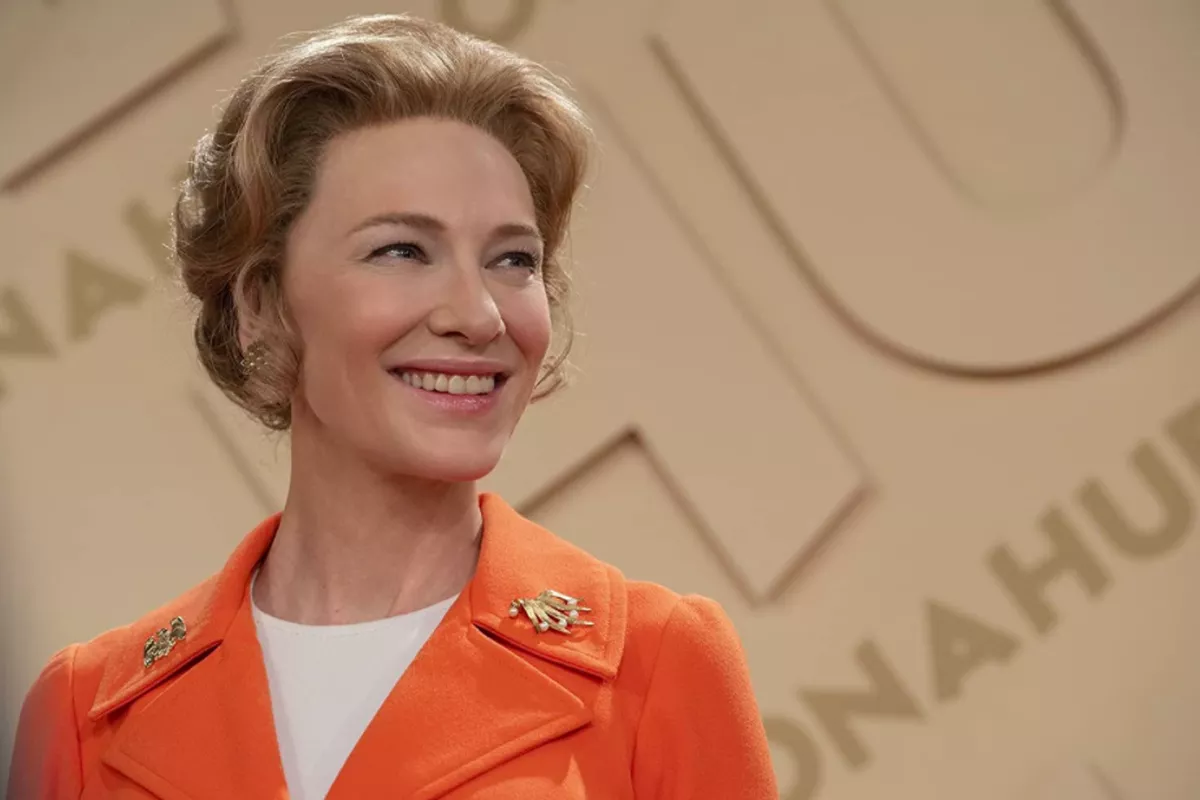Mrs. America: A Glimpse Into How Americans Perceive the Traditional Woman

Photo Courtesy of The Verge
By Renee Rasmussen
Recently released on Hulu, Mrs. America is a new series from FX about the 1970s political struggle to ratify the Equal Rights Amendment (ERA). The first three episodes were released on April 15, and in these episodes, viewers meet Phyllis Schlafly (played by Cate Blanchett), a conservative who campaigned against the ratification of the ERA, as well as her feminist opponents Gloria Steinem, Betty Friedan, Shirley Chisholm, Bella Abzug, and Jill Ruckelshaus.
The first episode, titled “Phyllis,” gives audiences a glimpse into the inner life of the political machine of Mrs. Schlafly. The opening shot of the series is Phyllis modeling a swimsuit for a political fundraiser. It is here, backstage after the event, that we learn that Phyllis ran for Congress twice and lost. At home, Phyllis seems to be the put-together wife: her hair and makeup are immaculately done, she bakes muffins for her husband’s office, and she helps her elderly mother pick out a nice dress. Yet, in the background, her children are fed by a maid, who seems to do most of the cooking and cleaning, and entertained by her sister-in-law, who seems to desperately cling to the family that Phyllis has created. When speaking to her husband, Phyllis always seems to be struggling to get the last word in, and through the fast-paced, wit-filled conversation we get a glimpse of the supposed “power struggle” between Phyllis and her husband, Fred. This struggle implodes later in the episode when, after returning from a day trip to Washington D.C., Fred pushes himself onto his wife, after her request many times for him to stop.
So when Mrs. Schlafly begins her S.T.O.P. ERA movement, uniting homemakers across the country, her struggle for power continues as she lets her jealousy and superiority leak through with fake smiles and crosswords. The storyline that follows Phyllis consistently makes her look ill-prepared, ignorant, and hypocritical. Her newfound political movement looks quite a bit like a career, and as she leaves her family to campaign against the ERA, her sister-in-law and hired maid pick up the slack. Her husband seems to be supportive, if not uninterested, helping her learn constitutional law, but putting her down in the process. The show seems to be making the statement that Phyllis Schlafly was a power-hungry, jealous woman who advocated for homemakers while barely making her own home. Topped off with a demanding and critical husband, Mrs. Schlafly and her tribe of housewives may have the traditional “American Dream” but they definitely are not happy, as told by these three episodes.
While based on facts, what Blanchett seems to have gotten wrong through her portrayal of Mrs. Schlafly is her love for her family and her kind, warm nature, according to The Washington Times.
“What I have seen in the trailers makes it clear to me that Cate Blanchett misunderstood my mother; her acting is cold, cruel, and calculating,” Anne Schlafly Cori, Phyllis Schlafly’s daughter, told Vanity Fair. “Phyllis Schlafly was warm and gracious and her beliefs were sincere. Women idolized Phyllis Schlafly.”
On the other hand, however, the feminists seem to be the much happier bunch. They celebrate their political wins with champagne and parties and viewers follow along as these women unite to ratify the ERA.
In episode two, titled “Gloria”, audiences learn more of the inner life of Gloria Steinem as she continues to push for the legalization of abortion into the feminist movement.
Through scenes of Gloria the show gives a deeper look of the confident leader: the male publisher of her magazine explains that he chose her to write for him because of her pretty legs, she is basically proposed to by her love interest, and through an intimate scene of Gloria tap-dancing alone in her house, we see a flashback of when she got a secret abortion. Before the abortion, the doctor makes Gloria promise that after this she will “do what [she] want[s] with [her] life.” When the viewers return to tap-dancing Gloria, now a leader of a major movement, the series seems to be making the statement that Gloria is a free, empowered woman unlike Mrs. Schlafly and her supporters who are held down by their abrasive husbands.
Still, the feminist movement is portrayed with its flaws as well. Throughout the episodes, the feminist women are constantly fighting. Betty Friedan doesn’t feel heard in the movement, Gloria wants more of a push on abortion, Shirley Chisholm doesn’t feel supported when she runs for president, and none of them agree with Jill Ruckelshaus when she says, “We don’t want housewives thinking we are against them.” The feminist movement is a movement whose major flaw is its inability to unite and agree.
This series gives a dark look into both sides of the story. It takes a true story of the battle to ratify the ERA and gives an intimate look at the inner battle each woman struggled with. The mini-series shows two sides of the same coin: Phyllis Schlafly, the idol for homemakers who seems to spend little time with her family, and Gloria Steinem, the woman preaching against marriage and tradition, who spends much of her free time getting wooed by a man who offers to marry her twice during the three episodes.








